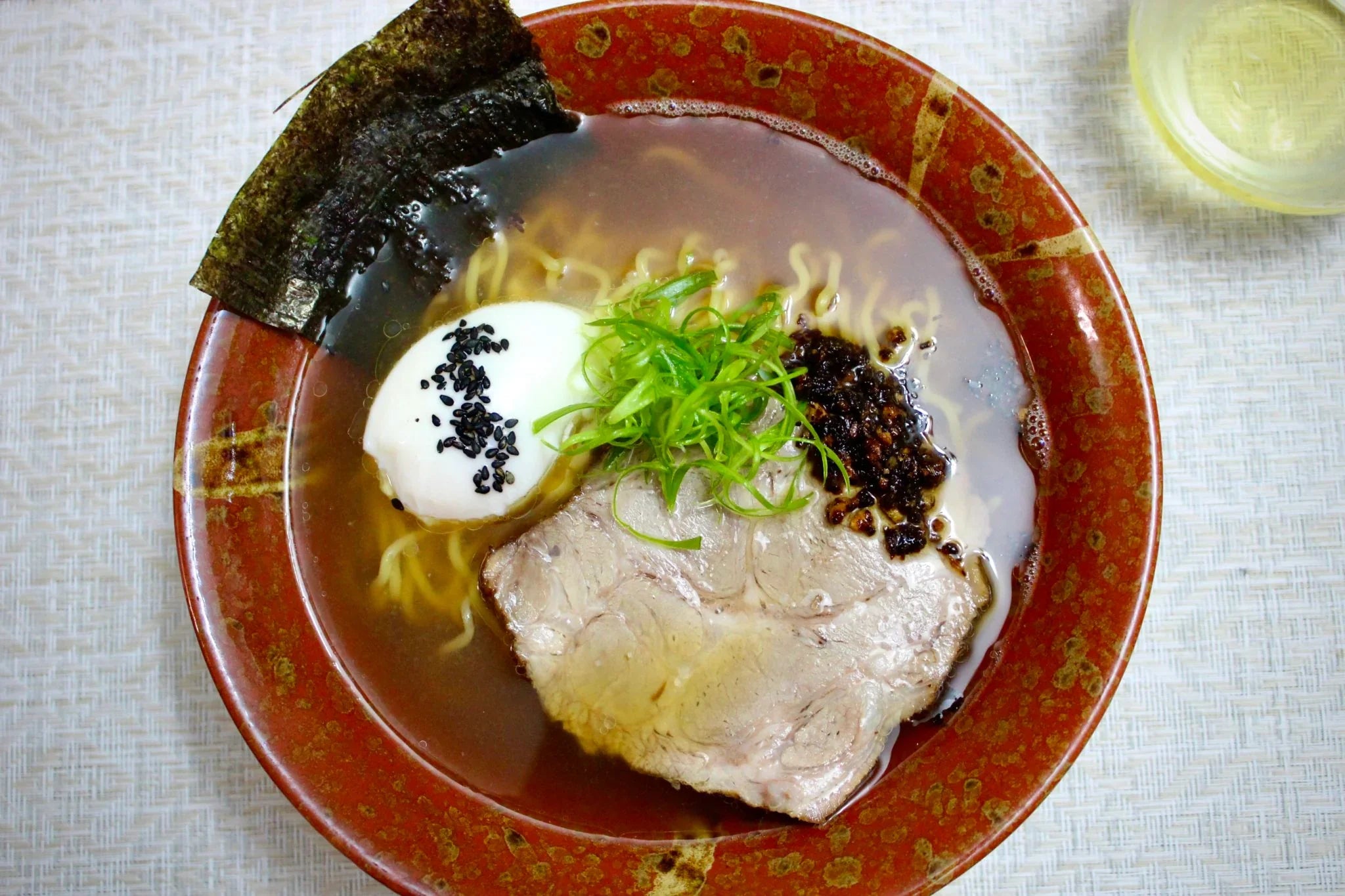
A beginner’s guide to ramen #2 – tare and aroma oil
By Brandon Muhawi
Senior Food Writer at Pro Home Cooks
If you’ve been to a traditional ramen restaurant and had the privilege to sit in view of the kitchen, there’s no doubt that you’ve seen the plethora of ladles flying around. The ramen assembly line runs on ladles of all shapes and sizes. Large ladles are used to pour that piping-hot broth into the bowl after leaving it on the stove all day, but other liquids need to be measured into the bowl as well. These would be the second and third components of a bowl of ramen – the tare and the aroma oil.
Tare

In a bowl of ramen, the tare determines the flavor profile. At most ramen restaurants, you’ll notice that the different bowls are labeled based on what tare is poured into the bowl. The most common tares are shio (salt-based), shoyu (soy sauce-based), and miso. Shio & shoyu tares are liquid in form and are simply added to the bowl before the broth is mixed in, while miso tare usually involves a more complex process. For the purposes of this guide, I will focus on introducing simple recipes and techniques in crafting a shio or shoyu tare.
It’s important to note that most shio and shoyu tares include dashi or other types of seafood. They won’t make the bowl fishy – they’re present to add umami & greater depth of flavor.
Shio Tare

Shio tares tend to have a cleaner flavor profile. In some cases, a shio tare can be stripped down to dissolved salts, allowing the flavors of the broth to shine on their own. These bowls are light, savory, and satisfying – not anything that will blow your taste buds off your tongue.
Most shio tares utilize MSG to boost the umami in the bowl. Salt alone will help bring out the flavors of the bowl, but salinity does not equate to umami. The glutamic acid present in MSG is essential in helping your taste buds perceive the umami in the dish. If you are at all hesitant about the prospect of consuming MSG, I encourage you to read about it. You might find that some of the most beloved snacks in your pantry are seasoned with monosodium glutamate. However, the choice is yours and a bowl of ramen without MSG can still be delicious.
Ingredients:
-
350ml water
-
10g konbu
-
35g coarse sea salt
-
20g MSG
-
10g katsuobushi (can be omitted, subbed for niboshi, etc.)
Instructions:
-
Combine water and konbu and allow to soak for 6 hours or overnight.
-
Pour water and konbu into a small saucepan and heat over medium-low. Keep the mixture at a bare simmer for 10-15 minutes.
-
Turn off the heat and stir in salt and MSG until dissolved. Add katsuobushi and let steep for 5 minutes.
-
Strain into a heatproof container.
-
Serve ~35ml tare per 350ml of soup (10% ratio).
Shoyu Tare
Shoyu tares often come with a greater depth and complexity in flavor compared to their shio counterparts. Because soy sauce on its own is a deeply strong flavor, shoyu tares have more freedom to include other bold ingredients without fear of them overpowering the dish.

If possible, I highly encourage you to buy the best available soy sauce for your shoyu tare. Soy sauce will be one of the main flavors in the bowl, so it is important that the shoyu used is of very high quality. Don’t be afraid to splurge here – very little soy sauce is used in each bowl and a shoyu tare will keep almost indefinitely in the refrigerator.* Kikkoman is the shoyu brand most Americans will be familiar with. The Kikkoman available in most American grocery stores is brewed in Wisconsin and is not the same as Kikkoman’s Japanese shoyu. If you are within reach of an Asian grocer, look for bottles that have been imported. You will be able to tell by the paper label that has been stuck onto the side of the bottle to translate the nutrition facts. These soy sauces will serve your bowl of ramen much better.
Ingredients:
-
300ml Japanese shoyu
-
40ml mirin
-
30ml sake
-
10g konbu
-
10g katsuobushi, dried shiitake mushrooms, or both
-
20g brown sugar
Instructions:
-
Combine shoyu, mirin, sake, and konbu in an airtight container and leave in the fridge for a minimum of 6 hours. Pour contents into a small saucepan and heat over medium-low to a bare simmer for 10-15 minutes.
-
Remove konbu from the saucepan. Increase heat until tare reaches a low boil. Turn off the heat and wait 45-60 seconds before adding katsuobushi. Stir to combine and let steep for 5 minutes.
-
Strain tare through a fine-mesh sieve into a heatproof container. Whisk in brown sugar until dissolved.
-
Serve ~35ml of tare per 350ml of soup (10% ratio).
*Both shio and shoyu tares will keep practically indefinitely when refrigerated. The salinity content of either is so high that there should be no fear of spoilage. Quality in taste might deteriorate over time, but the tare should still be safe to consume.
Aroma Oil

The aroma oil is usually one of the easiest components of ramen to make. The oil is most often added to the bottom of the bowl at the same time as the tare; before the broth is poured in. The oil does not emulsify with the broth but instead rises to the top of the bowl and forms bubbles that float above the soup. These droplets of oil attach themselves to the noodles as they are pulled from the soup and sit atop the broth as it’s sipped from the spoon – adding pleasant aromas and luxury to every slurp and sip.
In many cases, the aroma oil is made using the animal fat from the same meat as the broth – lard or chicken fat being the most common contenders. Animal fats are flavorful enough that they can be used as-is for the aroma oil. Plant-based oils, however, are a great choice because they taste cleaner on the tongue and absorb aromas very well. Plant-based fats and animal fats can be combined to create a more balanced aroma oil.
Aroma oils are a great place to experiment with aromatics, but for a first bowl, I would suggest sticking to the tried and true – scallions and garlic. Other great aromatic choices include ginger, onions, leeks, chili peppers, or even niboshi (dried sardines).
Here is an example of the process of crafting an aroma oil:
-
Combine 75ml of rendered pork fat with 75ml of neutral oil in a saucepan.
-
Thinly slice 50g scallions and crush 3-5 cloves of garlic. Add to saucepan and heat over medium-low heat, stirring occasionally.
-
Fry aromatics until deeply golden and the aroma of raw vegetables has become pleasantly nutty.
-
Carefully strain the aroma oil into a heatproof container and optionally reserve fried aromatics to use as a topping.
-
Serve 10-15ml of aroma oil per 350ml of soup.
* Aroma oils will keep almost indefinitely in the refrigerator, but the aromas will dissipate over time.
Bowl Construction

Once all of your liquid components have been produced, constructing the soup for your ramen is simple. First, warm your bowl by pouring in either hot water or broth and then pour it back out into its respective pot. (Usually, you would have both of these on the stove when making ramen. One to cook the noodles and one to warm the broth.) When the bowl is warm, add the designated amount of tare and aroma oil to the bottom of the bowl. Pour your broth over top and give a quick stir to combine!
The designated amount of tare and aroma oil per serving is only a suggestion. I would always recommend creating a “test” bowl to taste and adjust before continuing to serve your ramen. Some soy sauces are saltier, sometimes a broth will naturally have higher salinity than usual, etc. The ratios and amounts listed will generally work, but results will vary. If you want a saltier bowl, feel free to add a little more tare. If you’d like your bowl to be a little heavier and luxurious, add more aroma oil. Balance is key.
Final Thoughts
The tare recipes listed here are relatively basic and open to a lot of experimentation. By using the ratios built into the recipes, you are welcome to experiment as much as you’d like to craft bowls with different flavor profiles. Feel free to adjust ratios to your liking as well – add more sugar if you want your bowl a little sweeter or add a splash of rice vinegar if you think your bowl would benefit from a little acidity. If you cannot find quality katsuobushi near you, utilize the dried seafood that you can find – dried shrimp, sardines, and scallops ($$) are all excellent choices. Experiment with different soy sauces, or even different salts! There really are no rules, these are only here to serve as a baseline for what a delicious bowl of ramen might taste like. Enjoy!
Any questions or concerns? Are you an experienced ramen maker and find an error in this guide? Please feel free to email me at brandon@prohomecooks.com.
TOP ARTICLES

Sourdough Baking School
Master the art of sourdough bread baking in the most comprehensive baking class on the internet. This class features over three hours of baking content to help you start your sourdough journey.
See More
